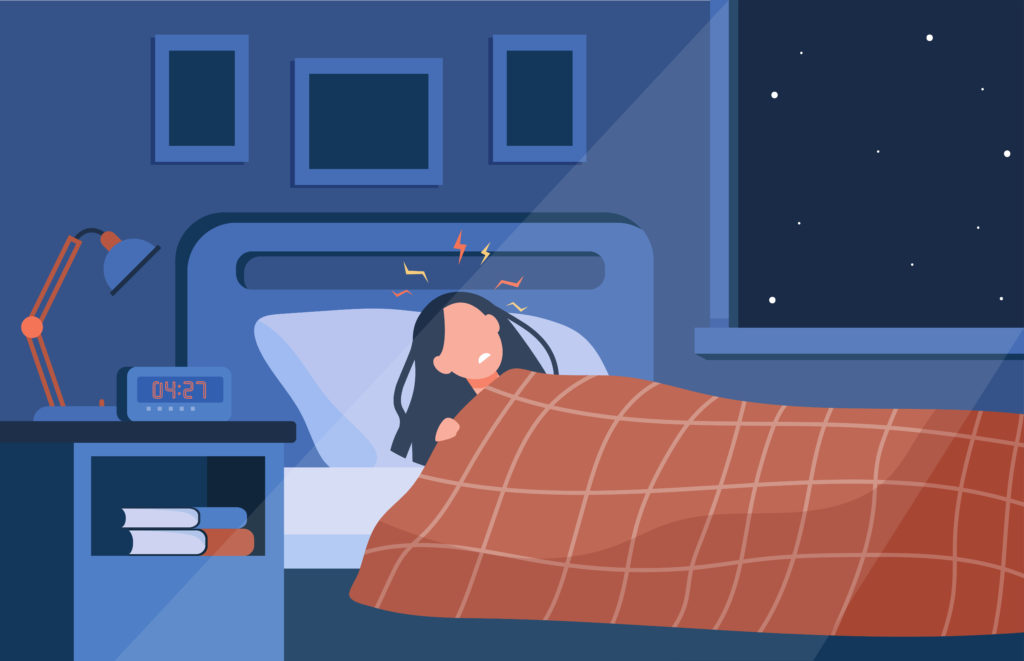
ACTION PLAN
Wake up at the same time every day
Treat yourself to some sunshine
Develop a morning ritual
Waking up in the middle of the night is never fun. Not being able to fall back to sleep makes it even worse. We know that it can be incredibly frustrating, which then makes it even more difficult to fall back to sleep. So, we’ve designed this comprehensive guide JUST FOR YOU! Here we’ll give you all of the top tips straight from the world’s best sleep experts and therapists.
Being unable to fall asleep is generally a combination of unhelpful learned associations and underlying stress. Unfortunately, the more time you’ve spent in bed “trying” to fall asleep, the more likely you are to have problems falling asleep.
HOW TO PREVENT WAKING IN THE MIDDLE OF THE NIGHT
1. LET'S TALK ABOUT SCHEDULES
The very first thing to address if you’re having difficulties falling asleep is your sleep schedule. Oftentimes, difficulties initiating sleep lead to inconsistent sleep and wake times. Here’s your action plan to fix it:
Wake up at the same time every day
You can’t always control when you fall asleep, but you CAN control when you wake up. Even if you’ve been up late or had a bad sleep, you should always aim to wake up at the same time every day.
Even on weekends? YES! It may be hard at first, so give yourself a window. Say you normally get up at 7 am on weekdays, try getting up between 7-8:30 on weekends.
What if I’m super tired? It’s possible that waking up at the same time every day may cause you to feel tired. In order to get back in sync with your circadian rhythm, it may require weathering a little fatigue. We encourage you to work through it by eating healthy, moving more, and getting some sunlight during the day. If you absolutely cannot function and feel like a zombie, try taking a 20-minute nap before 3pm. A nap is your last resort, but it’s better than sleeping in!
2. LET'S TALK ABOUT BUILDING A HYGGE SPACE
After the 20 minute mark of trying to get back to sleep, it’s best to relocate to a different room for a relaxing activity. This is recommended to ensure that you associate your bed and bedroom with sleep, instead of associating it with frustration when you can’t sleep.
Hygge (pronounced hue-ga) is the Norweigan and Scandanavian word for coziness. It is a way of life. You can make it your way of life when you can’t fall back to sleep in the middle of the night by building a hygge space in your home.
What is a hygge space?
It can be any space in your home, as long as it’s outside of your bedroom, and it’s purely dedicated to feeling cozy and relaxed. Fill it with pillows, blankets, a cozy rug, and candles!
Where do I build my hygge space?
Wherever you like, as long as it’s not in your bedroom. It needs to be in a quiet area and it should be near your bedroom, if possible.
What do I do in my hygge space?
Your hygge space is meant to be a space where you can relax and mentally decompress so that you can fall asleep quickly when you’re ready to return to bed. Here are some ideas:
MINDFULNESS MEDITATION
Try guided or use a timer and focus on your breath. Learn more about meditation techniques for relaxation.
YOGA OR STRETCHING
Helpful apps:
JOURNALING
This will give your mind closure on any looming duties. Learn more about journaling for better sleep.
What not to bring in your hygge space:
Do not bring your electronics, work, or items that will not bring you relaxation into your hygge space.
Make sure to return back to your bed when you're sleepy
You don’t want to fall asleep in your hygge space, so make sure to return back to your bed when you’re feeling tired enough to fall back to sleep. You can engage in these relaxing activities once you’ve snuggled under the covers. Here are the key relaxation techniques if you need help to lull your brain to sleep:
PROGRESSIVE MUSCLE RELAXATION
Helpful how-to video
Free guided audio
GUIDED VISUAL IMAGERY
GROUNDING TECHNIQUES
Learn 4 great grounding techniques that are going to help you relax to sleep
3. LET'S TALKING ABOUT BOOSTING YOUR DAYTIME
Did you know that it’s possible to improve your sleep quality by boosting your daytime? By engaging in healthy daytime activities, you can strengthen your circadian rhythm, which will help you to sleep through the night. Here are some tips on how you can boost your day:
Treat yourself to some sunshine
As little as 10 minutes of sun exposure early in the morning can help you sleep better at night. It’s true!
How will morning sunshine help my sleep? Well, sun exposure works to boost your natural “wake up” hormones and helps regulate your circadian rhythm. This keeps your brain, body, and sleep cycle healthy!
Tip: Try doubling up on benefits by pairing sun exposure with some fresh morning air! Fresh air is known to reduce stress and improve sleep.
Get yourself some exercise
Exercise can be so good for sleep that it’s sometimes prescribed as an alternative treatment for sleep problems! It can help you fall asleep faster, sleep longer and more efficiently, and increase your restorative deep sleep.
How to exercise your way to better sleep: If you currently aren’t exercising, any exercise that you enjoy is a great start. You should aim for around 20 minutes of daily exercise. There are three general categories of exercise that promote better sleep:
- Aerobic exercise (aim for 80% max heart rate)
- Strength training (pump the iron)
- Flexibility training (yoga, pilates, etc)
When exercise interferes with sleep: Keep the vigorous exercise to daytime hours and keep any evening exercise light as intense exercise too close to bedtime can increase alertness and might make it harder to sleep.
Tip: Walk it out. Grab your pet, spouse, or your headphones and head on out for a morning walk. A morning walk is a great way to get sunshine and exercise at the same time!
QUICK TIPS:
- Check out this article with techniques to help you fall asleep faster.






